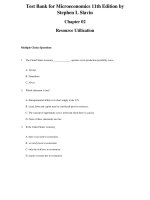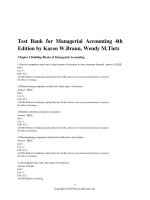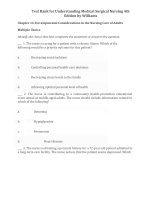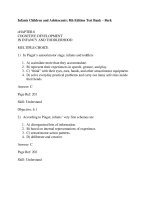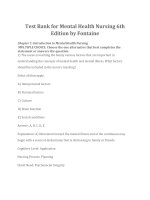Link full download test bank for nursing delegation and management of patient care 1st edition by motacki
Bạn đang xem bản rút gọn của tài liệu. Xem và tải ngay bản đầy đủ của tài liệu tại đây (162.77 KB, 14 trang )
Test Bank for Nursing Delegation and Management of
Patient Care 1st Edition by Motacki
Motacki: Nursing Delegation and Management of Patient Care
Chapter 04: Evidence-Based Practice
Test Bank
MULTIPLE CHOICE
1.
When providing care to patients, nurses use evidence-based practice whenever they:
a. Advise patients with musculoskeletal back pain to continue normal daily activities
within limits of their pain tolerance.
b. Advise patients with musculoskeletal back pain to remain on bedrest until pain has
been relieved by prescribed back exercise.
c. Advise patients that early premature activity with musculoskeletal pain may lead to
permanent disability.
d. Advise patients that continued normal activity after a musculoskeletal back injury
may result in delayed return to work.
ANS: A
Feedback
A
B
C
D
Research has demonstrated that with early ambulation, even patients with back
pain recover more quickly without complications.
Research has disproved these previous understandings about early ambulation.
Research has disproved these previous understandings about early ambulation.
Research has disproved these previous understandings about early ambulation.
DIF: Cognitive Level: Analysis
2.
When providing care to postoperative patients, nurses use evidence-based practice
whenever they:
a. Continue bedrest after surgery until the pain level is 1 on a scale of 1 to 10.
b. Continue bedrest after surgery until the pain level is 2 on a scale of 1 to 10.
c. Ambulate patients as soon as possible after surgery.
d. Ambulate patients as soon as they are awake from anesthesia.
Test Bank for Nursing Delegation and Management of Patient Care 1st Edition by Motacki
ANS: C
Feedback
A
B
C
D
According to the research, ambulation is not based on pain level.
According to the research, ambulation is not based on pain level.
Research supports the use of early ambulation in surgical patients.
This could possibly be an unsafe practice. The patient needs to be fully awake
and responsive after anesthesia prior to attempts to ambulate.
DIF: Cognitive Level: Analysis
3.
When providing care to patients, nurses understand that evidence-based practice supports
the concept that:
a. To avoid atelectasis and pneumonia, use of an incentive spirometer has an outcome
equal to coughing for a patient following surgery.
b. To avoid atelectasis and pneumonia, use of an incentive spirometer has a better
outcome than coughing for a patient following surgery.
c. To avoid atelectasis and pneumonia, use of an incentive spirometer has a worse
outcome than coughing for a patient following surgery.
d. Neither coughing nor use of an incentive spirometer will avoid atelectasis or
pneumonia in postoperative patients.
ANS: B
Feedback
A
B
C
D
Evidence supports the use of the incentive spirometer to prevent atelectasis
postoperatively.
Research supports the use of the incentive spirometer to avoid postoperative
atelectasis.
Evidence supports the use of the incentive spirometer to prevent atelectasis
postoperatively.
Evidence supports the use of the incentive spirometer to prevent atelectasis
postoperatively.
DIF: Cognitive Level: Application
Test Bank for Nursing Delegation and Management of Patient Care 1st Edition by Motacki
4.
When providing care to a child requiring temperature measurement, nurses use
evidencebased practice whenever they:
a. Understand that a rectal temperature is the most accurate method in a child.
b. Understand that a rectal temperature is the least accurate method in a child.
c. Understand that an axillary temperature is the most accurate method in a child.
d. Understand that adding 1ºC to an axillary temperature in a child is as accurate as a
rectal temperature.
ANS: A
Feedback
A
B
C
D
Research demonstrates the accuracy of taking rectal temperatures in children
versus the axillary mode.
Research supports the use of rectal temperature as the most accurate method to
use in children.
Research supports the use of rectal temperature as the most accurate method to
use in children.
Research supports the use of rectal temperature as the most accurate method to
use in children.
DIF: Cognitive Level: Application
5.
When providing care to patients at risk for ARDS, nurses use evidence-based practice
whenever they:
a. Suction a patient at high risk for developing ARDS every 2 hours.
b. Suction a patient at high risk for developing ARDS whenever crackles are
auscultated.
c. Turn a patient at risk for developing ARDS every 2 hours.
d. Turn a patient at risk for developing ARDS every 5 minutes.
ANS: D
Feedback
A
B
There is no evidence to support this as a measure to reduce the risk for patients
to develop ARDS.
There is no evidence to support this as a measure to reduce the risk for patients
to develop ARDS.
Test Bank for Nursing Delegation and Management of Patient Care 1st Edition by Motacki
C
D
There is no evidence to support this as a measure to reduce the risk for patients
to develop ARDS.
Research has shown that turning patients at risk for developing ARDS every 5
minutes reduces that risk. There are hospital beds now designed to provide that
care.
DIF: Cognitive Level: Application
6.
When providing care to patients, nurses use evidence-based practice to avoid urinary tract
infections whenever the insertion of a urinary catheter is performed by: a. A UAP.
b. An RN.
c. An LPN.
d. A senior nursing student.
ANS: B
Feedback
A
B
C
D
There is no evidence to support the use of this staff member in inserting urinary
catheters to avoid urinary tract infections.
Research supports the use of only RNs to insert urinary catheters to avoid
urinary tract infections.
There is no evidence to support the use of this staff member in inserting urinary
catheters to avoid urinary tract infections.
There is no evidence to support the use of this staff member in inserting urinary
catheters to avoid urinary tract infections.
DIF: Cognitive Level: Application
7.
When collecting data for research purposes on patient safety methods, the nurse would use:
a. Maximum census of patients on a specific unit over the course of admissions for 1
year.
b. Maximum census of the entire hospital over the course of admissions for 1 year.
c. Information obtained in other, similar research projects.
d. Appropriate research design.
ANS: B
Test Bank for Nursing Delegation and Management of Patient Care 1st Edition by Motacki
Feedback
A
B
C
D
May be too small of a sample to produce valid or reliable data.
Reliable research results are usually supported by the study of larger samples.
Other studies may not provide data appropriate to the specific question to be
researched and the studies must be validated before they are relied on.
Research design cannot be the essential factor to confirm validity.
DIF: Cognitive Level: Application
8.
The nurse explains the PICO acronym to colleagues in which of the following ways?
a. PICO represents the questions to ask regarding application of the research to the
specific setting.
b. PICO represents the trigger for initiating the research.
c. PICO represents the benchmarking website used in research.
d. PICO represents the regulatory guidelines established for practitioners.
ANS: A
Feedback
A
B
C
D
PICO is the acronym used in formulating research questions and stands for P =
patient or population, I = intervention, C = comparison or alternative
intervention used, and O = outcomes.
Does not represent the purpose or focus of the acronym PICO.
Does not represent the purpose or focus of the acronym PICO.
Does not represent the purpose or focus of the acronym PICO.
DIF: Cognitive Level: Analysis
9.
When making clinical practice changes, nurses should make permanent changes based on:
a. Reviewing other unit practices
b. Reviewing case reports
c. Obtaining expert opinions
d. Implementing piloting changes
ANS: D
Test Bank for Nursing Delegation and Management of Patient Care 1st Edition by Motacki
Feedback
A
B
C
D
Not supported by research.
Not supported by research.
Not supported by research.
Piloted changes should be implemented first because there are data to support
them.
DIF: Cognitive Level: Analysis
10. When integrating evidence-based research into practice, the nurse understands that the type
of research is important to the application of a particular nursing unit. Which of the
following factors is most important in determining the usefulness of the research to the
needs of the practice?
a. Randomized clinical trials
b. Case studies
c. Anecdotal information
d. Single correctional studies
ANS: A
Feedback
A
B
C
D
Randomized trials are clinically the most reliable because of the randomization
of the group studied.
Not a good method for establishing reliability in research.
Not a good method for establishing reliability in research.
Not a good method for establishing reliability in research.
DIF: Cognitive Level: Application
11. A novice nurse observes change differences in practice from what was taught in nursing
school and expresses confusion to the nurse manager. The nurse manager suggests which
of the following methods as the best resource to determine best practice in the clinical
setting?
a. Ask a former faculty member.
b. Review the textbook used during nursing school.
c. Research electronic databases such as CINAHL.
d. Attend professional conferences.
Test Bank for Nursing Delegation and Management of Patient Care 1st Edition by Motacki
ANS: D
Feedback
A
B
C
D
May not provide current research information.
May not provide current research information.
Will provide only current published research. Sometimes the time between the
actual research and its publication may be lengthy and cause it to be irrelevant.
Professional conferences usually present current research.
DIF: Cognitive Level: Analysis
12. Harm to patients from medication errors is a component to initiation of research in which
of the following ways?
a. Establishing a question
b. Establishing a solution
c. Establishing a population sample
d. Establishing a cost benefit
ANS: A
Feedback
A
B
C
D
Establishing the questions is a major first step to initiating research. In the case,
the question is WHY?
Not part of the initial steps for establishing reasons for research.
Not part of the initial steps for establishing reasons for research.
Not part of the initial steps for establishing reasons for research.
DIF: Cognitive Level: Analysis
13. Which responses by nurses incorporate reasons for resistance to research utilization?
a. “I want to see the outcomes for the patients.”
b. “I believe that patients will not benefit from this change.”
c. “I’ve grown tired of doing it the same way.”
d. “I’m ready for a change.”
Test Bank for Nursing Delegation and Management of Patient Care 1st Edition by Motacki
ANS: B
Feedback
A
B
C
D
Shows interest in the possible change and not resistance.
Some people are resistant to change because they have a belief that it will not be
beneficial to the patient or themselves.
Shows interest in the possible change and not resistance.
Shows interest in the possible change and not resistance.
DIF: Cognitive Level: Analysis
14. A student nurse is conducting a research project for school. Although this is a new
assignment, she understands that the quickest and most dependable source of information
is the Internet. Which resources require intervention by the instructor? a. Wikipedia
b. CINAHL
c. MEDLINE
d. Online nursing journals
ANS: A
Feedback
A
B
C
D
This is not a reliable source for research purposes and would require intervention
by the instructor.
This is a legitimate source for research and does not require intervention.
This is a legitimate source for research and does not require intervention.
This is a legitimate source for research and does not require intervention.
DIF: Cognitive Level: Application
15. A nurse involved in evaluating the validity of research prior to implementation should
consider which of the following as the most important hierarchical evidence for
effectiveness?
a. Opinions from experts
b. Single observational studies
c. Randomized controlled versus nonrandomized trials
d. Systematic review study
Test Bank for Nursing Delegation and Management of Patient Care 1st Edition by Motacki
ANS: C
Feedback
A
B
C
D
This is less important for determining the importance of the study.
This is less important for determining the importance of the study.
Randomized controlled studies are most important for determining the
effectiveness of the study.
This is less important for determining the importance of the study.
DIF: Cognitive Level: Application
16. Of the steps to implementation, research is not complete until which of the following steps
is accomplished?
a. Synthesizing relevant research
b. Determining the sufficiency of the sample
c. Instituting the change
d. Monitoring the outcome
ANS: D
Feedback
A
B
C
D
This is a step to implementation but is not the final step.
This is a step to implementation but is not the final step.
This is a step to implementation but is not the final step.
Monitoring the outcome is the final step in determining whether to continue with
the new practice.
DIF: Cognitive Level: Application
17. Which of the following would be considered a sentinel event?
a. Patient who has developed a fatal mediastinal infection 7 days after cardiac surgery
b. Patient who experiences a CVA during a cardiac catheterization
c. Patient who receives a double dose of a medication in error
d. Wrong patient scheduled for a chest radiograph
ANS: A
Test Bank for Nursing Delegation and Management of Patient Care 1st Edition by Motacki
Feedback
A
B
C
D
The unexpected death of a patient is a sentinel event and would require
investigation by the appropriate hospital committee.
Does not qualify as a sentinel event.
Does not qualify as a sentinel event.
Does not qualify as a sentinel event.
DIF: Cognitive Level: Analysis
18. Which of the following would most likely present the most difficult step in research
utilization?
a. Monitoring outcomes
b. Determining the research question
c. Instituting the change
d. Piloting the project
ANS: C
Feedback
A
B
C
D
This is a step in research utilization but is not the hardest to implement.
This is a step in research utilization but is not the hardest to implement.
Buy-in by the staff may be the most difficult step because people are usually
very resistant to change.
This is a step in research utilization but is not the hardest to implement.
DIF: Cognitive Level: Analysis
MULTIPLE RESPONSE
1. When providing care to patients, nurses make patient care decisions based on which of the
following? Select all that apply. a. Resource availability
b. Nurse practice act
c. Shared governance
d. Managerial leadership style
e. Tradition
f. Clinical circumstances
Test Bank for Nursing Delegation and Management of Patient Care 1st Edition by Motacki
ANS: B, E, F
Feedback
Correct
Incorrect
This is a component relied on in making patient care decisions in nursing.
This is a component relied on in making patient care decisions in nursing.
This is a component relied on in making patient care decisions in nursing.
Not part of the nurse’s decision-making process.
Not part of the nurse’s decision-making process.
Not part of the nurse’s decision-making process.
DIF: Cognitive Level: Application
2. In determining the applicability of a research study, the nurse must look at many factors.
Which factors can be used to determine appropriateness of the research to the individual
setting? Select all that apply. a. Sample size
b. Credentials of authors
c. Time element
d. Context
e. Intervention used
ANS: A, D, E
Feedback
Correct
Incorrect
Research to be used in clinical practice should have appropriate sample
size.
Research to be used in clinical practice should have context to current
question to be researched.
Research to be used in clinical practice should have appropriateness of
intervention.
Not a factor used to support validity or applicability. Not
a factor used to support validity or applicability.
DIF: Cognitive Level: Application
3. Based on the Iowa model for evidence-based practice, research is initiated because of
either problem- or knowledge-based triggers. The nurse understands that these triggers
may arise as a result of (select all that apply): a. Staff complaints
Test Bank for Nursing Delegation and Management of Patient Care 1st Edition by Motacki
b. An increase in surgical infection rates
c. An increase in chronic renal failure following use of dye during radiographic
procedures in diabetic patients
d. Medicare reimbursement changes
e. A new nurse manager
ANS: B, C, D
Feedback
Correct
Incorrect
This is a possible trigger of problems or knowledge that leads to research
according to the Iowa model for evidence-based practice.
This is a possible trigger of problems or knowledge that leads to research
according to the Iowa model for evidence-based practice.
This is a possible trigger of problems or knowledge that leads to research
according to the Iowa model for evidence-based practice.
Not usually the basis to support research.
Not usually the basis to support research.
DIF: Cognitive Level: Analysis
4. After piloting changes based on evidence-based research, the nurse understands that they
will be instituted as a result of the effects on which of the following? Select all that apply.
a. Staff
b. Number of UAPs available
c. Cost
d. Patient
e. Census
ANS: A, C, D
Feedback
Correct
Incorrect
Changes based on research will ultimately be instituted based on the
effects of these factors.
Changes based on research will ultimately be instituted based on the
effects of these factors.
Changes based on research will ultimately be instituted based on the
effects of these factors.
Does not generally affect the institution of the research.
Does not generally affect the institution of the research.
Test Bank for Nursing Delegation and Management of Patient Care 1st Edition by Motacki
DIF: Cognitive Level: Application
5. After piloting an evidence-based clinical practice change, the nurse would (select all that
apply):
a. Institute the change.
b. Pilot the project until the desired outcome is achieved.
c. Determine applicability for use.
d. Incorporate changes into practice
e. Pilot the project until consensus is achieved.
ANS: A, C, D
Feedback
Correct
Incorrect
Following the appropriate piloting of a project, the changes should be
implemented after determining applicability.
Following the appropriate piloting of a project, the changes should be
implemented after determining applicability.
Following the appropriate piloting of a project, the changes should be
implemented after determining applicability.
This is counterproductive to legitimate research. This
is counterproductive to legitimate research.
DIF: Cognitive Level: Application
6. Maintaining currency in a profession is achieved through (select all that apply):
a. Academic inquiry.
b. Continuous participation in professional organizations.
c. Asking questions of other professionals.
d. Observing your role model’s practice.
e. Participation in evidence based projects.
ANS: A, B, E
Feedback
Test Bank for Nursing Delegation and Management of Patient Care 1st Edition by Motacki
Correct
Incorrect
This is a method by which the professional nurse would keep current.
This is a method by which the professional nurse would keep current.
This is a method by which the professional nurse would keep current.
This is an incorrect method for maintaining professional currency because
it does not ensure accuracy or currency.
This is an incorrect method for maintaining professional currency because
it does not ensure accuracy or currency.
DIF: Cognitive Level: Analysis
7. The questions that nurse researchers should ask before beginning their study include which
of the following? Select all that apply a. Why are we doing it this way?
b. Where is the evidence to support this practice?
c. How much will it cost to change?
d. Can we as nurses lose our jobs if we implement this?
e. What is a better way of doing this?
ANS: A, B, E
Feedback
Correct
Incorrect
Questions should be asked about why we practice the way we currently do
and why we should want to change that practice before beginning any
research.
Questions should be asked about why we practice the way we currently do
and why we should want to change that practice before beginning any
research.
Questions should be asked about why we practice the way we currently do
and why we should want to change that practice before beginning any
research.
Should not be relevant to practice change. Should
not be relevant to practice change.
DIF: Cognitive Level: Application
Test Bank for Nursing Delegation and Management of Patient Care 1st Edition by Motacki
